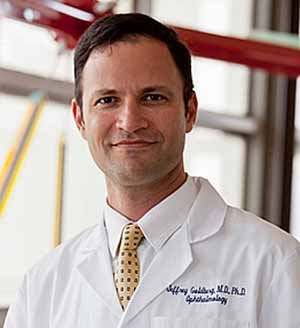Looking Ahead: Whole Eye Transplant Under Development
Published Date
By:
- Scott LaFee
- Christina Johnson
Share This:
Article Content
The concept of a whole eye transplant seems futuristic, if not impossible. But with a $1 million grant from the U.S. Department of Defense, researchers at University of California, San Diego School of Medicine hope to someday make implantation of an entire, functional eye a reality.

“A whole eye transplant could be a holy grail for vision restoration,” said Jeffrey Goldberg, MD, PhD, professor of ophthalmology and grant co-recipient with colleagues at University of Pittsburgh Medical Center and Boston Children’s Hospital/Harvard University. “It is in the realm of scientific plausibility.”
The basic idea is straightforward: Doctors would implant a donor eye in the recipient's eye socket. The vascular system to the eye would be re-established, as would the eye’s musculature to enable normal movement. The greater challenge – and focus of the two-year project – would be devising effective methods to reconnect the eye's neuronal wiring to the brain through the optic nerve, which contains more than 1 million nerve cells and transmits visual information from the retina.
Past experiments at University of Pittsburgh Medical Center have demonstrated the ability to perform whole eye transplants in genetically inbred rats (selected to minimize issues of tissue rejection). But while retinal tissue in the transplanted eyes appeared healthy, the optic nerves did not recover and regenerate connections, eliminating the possibility of restored sight.
“We know from previous experiments that the biggest scientific hurdle is not hooking up all the eye’s tiny blood vessels or its musculature,” said Goldberg, who is also director of research at UC San Diego Shiley Eye Center. “It's that when you cut the optic nerve, the nerve cells do not regrow.”
“Our goal for this project is to be able to transplant a whole eye in an animal model and successfully demonstrate neuronal regrowth from the donor’s eye to the recipient’s optic nerve,” he said.
Researchers at UC San Diego and Harvard University have developed a variety of molecular techniques for enhancing optic nerve regeneration. One of the primary objectives is to assess whether these different techniques can be combined for greater therapeutic effect.
Among the most promising is restoring the embryonic ability of adult nerve cells to grow and blocking production of molecules that squelch nerve cells’ initial intrinsic regenerative properties. This loss of regenerative capacity is similar to what happens in spinal cord injuries that result in permanent paralysis.
Scientists have also identified proteins in the optic nerve known as neurotrophic factors that are involved in growth, survival and maintenance of developing neurons and have developed techniques for enhancing their signaling to nerve cells. Other “molecular tricks” will be used to try to overcome the inhibitory environment for re-growth normally found in the optic nerve.
If successful, researchers suggest whole eye transplants might restore sight in a wide range of patients who are blind due to structural or functional problems in the eye. For example, an estimated 120,000 Americans are blind due to damage to their optic nerves caused by glaucoma. An estimated 186,855 eye injuries were incurred by deployed U.S. military personnel from 2000 to 2010, usually related to traumatic brain injury. Some of these cases might be remedied through eye transplants in the future.
Share This:
You May Also Like
UC San Diego is Strengthening U.S. Semiconductor Innovation and Workforce Development
Technology & EngineeringStay in the Know
Keep up with all the latest from UC San Diego. Subscribe to the newsletter today.



